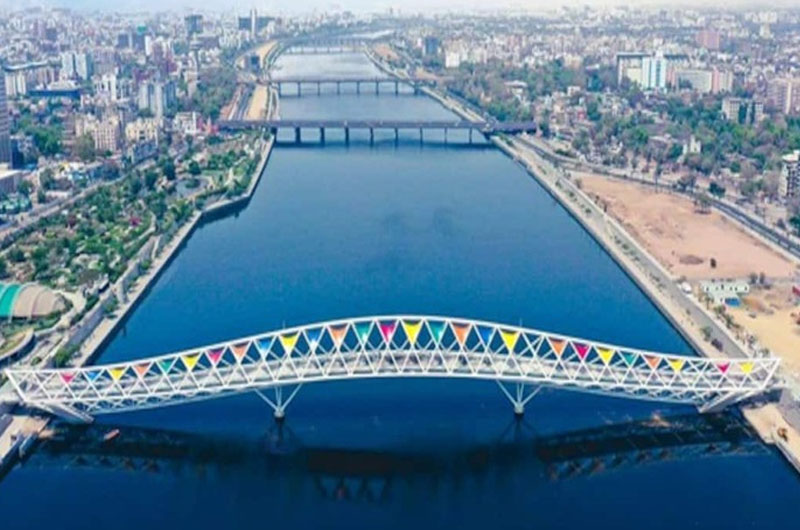
The Serene Sabarmati River: A Journey Through Ahmedabad’s Lifeline
The Sabarmati River, coursing through the heart of Gujarat, India, is more than just a waterway. It holds significant historical, cultural, and economic importance for the region. Flowing through the vibrant city of Ahmedabad, the Sabarmati River has been a witness to the city’s evolution and has played a pivotal role in shaping its identity. This detailed guide explores the Sabarmati River’s tourism specialties, locality, nearby tourist spots, historical significance, the best times to visit, and practical travel information, providing an enriching experience for travelers.
1. Overview of the Sabarmati River
1.1 Geographic Location and Course
- Origin: The Sabarmati River originates in the Aravalli Range of the Udaipur District in Rajasthan.
- Course: It flows southward through the Indian states of Rajasthan and Gujarat, passing through the city of Ahmedabad before emptying into the Gulf of Khambhat in the Arabian Sea.
- Length: The Sabarmati River stretches approximately 371 kilometers, making it a crucial river for the region.
1.2 Importance and Significance
- Economic Impact: The Sabarmati River is vital for irrigation, supporting agriculture in the region. The Sabarmati Riverfront project has also boosted the local economy through tourism and real estate development.
- Cultural Impact: The river is deeply embedded in the cultural and historical fabric of Gujarat, particularly Ahmedabad, home to several significant landmarks and events in Indian history.
2. Tourism Specialty
2.1 Scenic Beauty
- Riverfront Development: The Sabarmati Riverfront offers beautifully landscaped promenades, parks, and recreational areas, providing a serene environment for visitors.
- Natural Splendor: The river, especially during the monsoon season, is flanked by lush greenery, creating picturesque landscapes.
2.2 Historical and Cultural Significance
- Gandhi Ashram: Situated on the banks of the Sabarmati, this historic site was the residence of Mahatma Gandhi and serves as a museum showcasing his life and works.
- Heritage Walks: The riverbanks are lined with heritage sites, including ancient temples and old city architecture, reflecting the rich cultural heritage of Ahmedabad.
2.3 Adventure and Activities
- Boating and Water Sports: The riverfront offers various water activities, including boating and jet skiing, providing an exciting experience for adventure enthusiasts.
- Cycling and Jogging: Dedicated tracks along the riverfront are perfect for cycling and jogging, attracting fitness enthusiasts.
3. Locality and Major Cities
3.1 Key Cities Along the Sabarmati
- Ahmedabad: The largest city on the banks of the Sabarmati, known for its historical significance, vibrant culture, and economic importance.
3.2 Nearby Tourist Spots
- Ahmedabad:
- Sabarmati Ashram: A must-visit for anyone interested in Indian history and the life of Mahatma Gandhi.
- Sidi Saiyyed Mosque: Famous for its intricate stone latticework, known as the Sidi Saiyyed Jali.
- Kankaria Lake: A popular recreational spot with a zoo, toy train, and amusement park.
- Adalaj Stepwell: An architectural marvel and historic stepwell located near Ahmedabad.
- Jhulta Minara: A pair of shaking minarets that demonstrate the architectural ingenuity of the region.
4. History of the Sabarmati River
4.1 Ancient Significance
- Historical References: The Sabarmati River has been mentioned in various ancient texts, indicating its importance in regional trade and agriculture.
- Mythological Connections: The river is associated with various local legends and myths, reflecting its cultural significance in ancient Indian traditions.
4.2 Medieval and Modern History
- Medieval Period: During the medieval period, the Sabarmati River played a crucial role in the region’s history, influencing local kingdoms and their economic activities. Several temples and monuments along its banks were built during this time.
- Colonial Era and Post-Independence: In the colonial era, the river was important for irrigation and flood control projects. Post-independence, it has continued to support agriculture and local communities while also becoming a focus for conservation and tourism.
5. Best Time to Visit
5.1 Ideal Seasons
- Winter (October to March): The weather is pleasant, making it the ideal time for exploring the river and its surroundings. This season is perfect for outdoor activities, sightseeing, and enjoying river-based activities like boating.
- Summer (April to June): The weather can be quite hot, but early mornings and late evenings can still be enjoyable.
- Monsoon (July to September): The river experiences increased flow and can be prone to flooding during the monsoon season. While the lush greenery and dynamic river are attractive, travel might be challenging due to heavy rains.
5.2 Special Events
- International Kite Festival: Held in January, this festival attracts kite enthusiasts from all over the world, and the riverfront is one of the prime spots for kite flying.
- Navratri Festival: Celebrated in October, the riverfront comes alive with Garba and Dandiya Raas, traditional dance forms of Gujarat.
6. Nearby Restaurants and Hotels
6.1 Restaurants
- Agashiye: A rooftop restaurant offering traditional Gujarati thali and a splendid view of the city.
- Swati Snacks: Famous for its authentic Gujarati snacks and light meals.
- Manek Chowk: A bustling food market that transforms into a foodie’s paradise at night, offering a variety of local delicacies.
6.2 Hotels
- The House of MG: A heritage hotel offering luxurious accommodations with modern amenities and a glimpse into the city’s history.
- Hyatt Regency Ahmedabad: Provides modern amenities, comfortable rooms, and excellent service, located near the riverfront.
- Lemon Tree Premier, The Atrium: Overlooking the Sabarmati River, this hotel offers comfortable accommodations with a blend of traditional and contemporary decor.
Conclusion
The Sabarmati River, with its historical, cultural, and natural significance, provides a unique destination for travelers exploring Gujarat. From its picturesque landscapes and serene waterways to its rich history and cultural heritage, the Sabarmati River offers diverse experiences for visitors. Whether you are interested in nature, history, or local traditions, the Sabarmati River promises a memorable and enriching journey through one of India’s most vital waterways.
